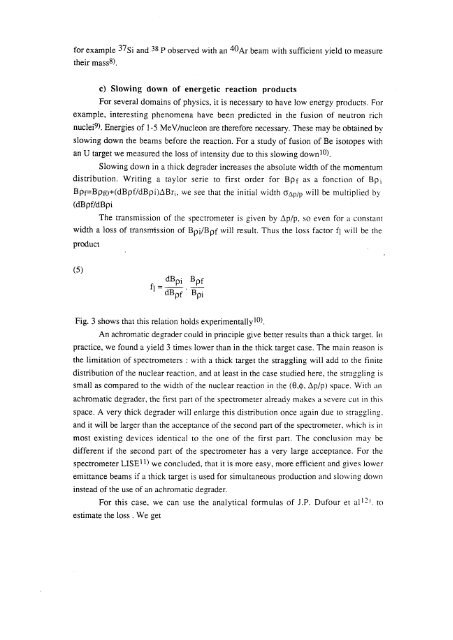Radioactive beams by fragmentation and ISOL techniques - CERN
Radioactive beams by fragmentation and ISOL techniques - CERN
Radioactive beams by fragmentation and ISOL techniques - CERN
You also want an ePaper? Increase the reach of your titles
YUMPU automatically turns print PDFs into web optimized ePapers that Google loves.
37<br />
for example Si <strong>and</strong> 38 P observed with an 40Ar beam with sufficient yield to measure<br />
their massgl.<br />
product<br />
(5)<br />
c) Slowing down of energetic reaction products<br />
For several domains of physics, it is necessary to have low energy products. For<br />
example, interesting phenomena have been predicted in the fusion of neutron rich<br />
nuclei9). Energies of 1-5 MeV/nucleon are therefore necessary. These may be obtained <strong>by</strong><br />
slowing down the <strong>beams</strong> before the reaction. For a study of fusion of Be isotopes with<br />
an U target we measured the loss of intensity due to this slowing down]<br />
Slowing down in a thick degrader increases the absolute width of the momentum<br />
distribution. Writing a taylor serie to first order for Bpy as a fonction of Bp,<br />
Bp{=Bp{()+(dBpf/dBpi)ABri, we see that the initial width GA;)/p will be multiplied <strong>by</strong><br />
(dBpf/dBpi<br />
The transmission of the spectrometer is given <strong>by</strong> Ap/p, so even for a constant<br />
width a loss of transmission of Bpi/Bpf will result. Thus the loss factor fi will be the<br />
Fig. 3 shows that this relation holds experimentallyl<br />
An achromatic degrader could in principle give better results than a thick target. In<br />
practice, we found a yield 3 times lower than in the thick target case. The main reason is<br />
the limitation of spectrometers : with a thick target the straggling will add to the finite<br />
distribution of the nuclear reaction, <strong>and</strong> at least in the case studied here, the straggling is<br />
small as compared to the width of the nuclear reaction in the (9,q>, Ap/p) space. With an<br />
achromatic degrader, the Hrst part of the spectrometer already makes a severe cut in this<br />
space. A very thick degader will enlarge this distribution once again due to straggling.<br />
<strong>and</strong> it will be larger than the acceptance of the second part of the spectrometer, which is in<br />
most existing devices identical to the one of the first part. The conclusion may be<br />
different if the second part of the spectrometer has a very large acceptance. For the<br />
spectrometer LISEwe U) concluded, that it is more easy, more efficient <strong>and</strong> gives lower<br />
emittance <strong>beams</strong> if a thick target is used for simultaneous production <strong>and</strong> slowing down<br />
instead of the use of an achromatic degrader.<br />
For this case, we can use the analytical formulas of J.P. Dufour et allil. to<br />
estimate the loss . We get OCR Output<br />
f, 2 _<br />
dBp{ Bpi<br />
&Ea















